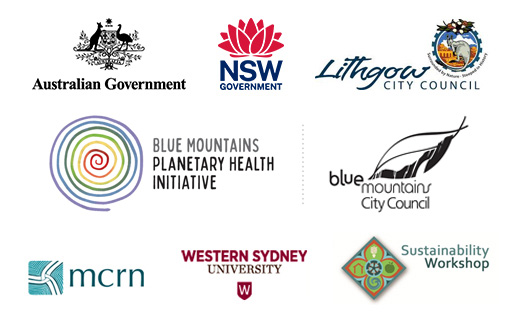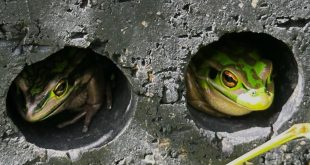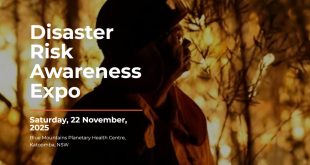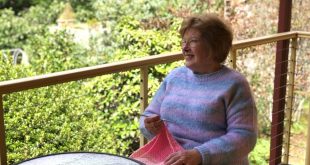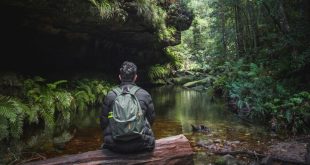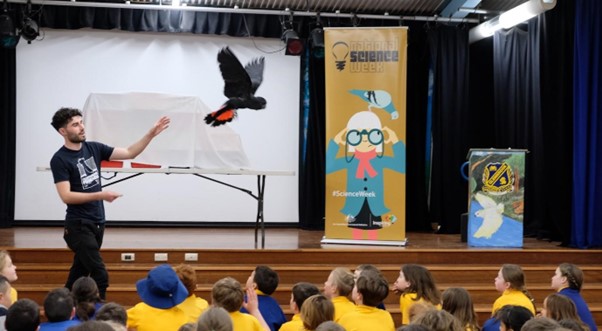
Feathered Friends bring Glenbrook Public School students up close and personal to Australia’s vulnerable Glossy Black Cockatoo at this year’s National Science Week event. (Photo: courtesy Glenbrook Public School/A. Mostaert )
Story by Gabiann Marin
The South Eastern Glossy Black Cockatoo has seen declining numbers over recent years with current estimates indicating that they could be one of Australia’s rarest native birds, with a current population of just 8000. This beautiful avian is in desperate need of help, with habitat destruction, pollution and invasive species some of the main drivers for its decline in numbers.
Happily the staff and students at Glenbrook Public School were not willing to give up on the flocks who make their home in the Blue Mountains region. Helping the Glossy Black Cockatoo was the focus of their recent National Science Week program.
Key Points:
- Glossy Black Cockatoos are endangered. Their numbers have declined significantly due to habitat loss and impacts of climate change.
- Glenbrook Public School focused on the birds for this year’s National Science Week. They organised cool activities to educate students about the importance of Glossy Black Cockatoos and their habitat.
- Students learned and took action, planting Allocasuarina trees, and observing the birds firsthand.
Despite being deemed one of Australia’s vulnerable native birds, there was an abundance of Glossy Black Cockatoos at Glenbrook Public School during the recent National Science Week. Beautifully crafted cockatoo mobiles fluttered across the playground, posters and informational flyers adorned every available wall in the school library, and the birds themselves flew across the school hall in a breathtaking display provided by local bird sanctuary Feathered Friends.
Throughout it all, children from classes K – 6 were enthralled and inspired to do what they could to help this highly threatened bird species.
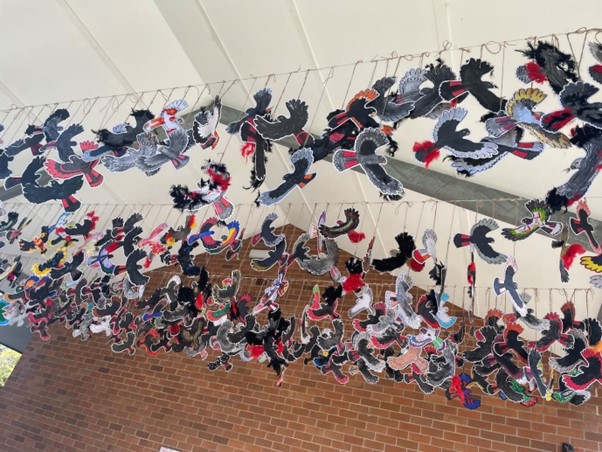
An explosion of colourful cockatoos at Glenbrook Public School as students learn about saving this important species. (Photo: courtesy Glenbrook Public School/A. Mostaert)
Glossy Black Cockatoos, one of the smallest and rarest of Australia’s cockatoo family, used to be a regular sight across the Blue Mountains. They made their homes in hollowed out trees and ate the once plentiful Allocasuarina seeds abundant in the bush. But continued habitat loss due to deforestation, pressure of human habitation and effects of climate change have resulted in a marked reduction in the number of Glossy Blacks in our local environment.
The news is not much better elsewhere. The Glossy Black, once found all across the woodlands of the South Eastern Seaboard up as far as Queensland, has seen its numbers reduced to less than 8000 individuals, gaining it the unwanted label of vulnerable according to information released by the World Wildlife Fund for Nature.
The situation is worse for the smaller subspecies of Kangaroo Island Glossy Black, found only on the island of the same name off the coast of South Australia. Its numbers have decreased so rapidly they are now labelled as endangered, requiring urgent conservation efforts to ensure their continued survival.

Glossy Black Cockatoos are reliant on Allocasuarina or she-oak for their habitat and diet, eating up to 580 seed pods per day! (Photo: courtesy Creative Commons)
Identifying Glossy Black Cockatoos
Although often mistaken for some of the larger species of Black Cockatoo, the Glossy Black has quite a few distinctive features, including an appearance that varies across the sexes. While both male and female birds have their distinctive black feathers, the female sports bright joyful yellow tail feathers and cheek plumage. She is often mistakenly identified as a Yellow-tailed Black Cockatoo, while the male’s tail is a burst of bright red, similar to that of his larger cousin, the Red-tailed Black Cockatoo.
One of the best ways to differentiate them is that the Glossy Black Cockatoo has a more rounded head, bulbous beak and softer call than other Black Cockatoo species.
While the loss of a beautiful creature such as the Glossy Black Cockatoo would be heartbreaking in its own right, their decline is also a clear indication of a struggling ecosystem. Glossy Blacks thrive where there is strong plant diversity, and help maintain ecosystem health through acting as a kind of bush gardener, distributing seeds, pruning foliage and making their nests in the hollows of old eucalypts.
Supporting these birds is a great way of ensuring the overall environment is supported, which is why for this year’s National Science Week the staff, parents and students of Glenbrook Public School decided that they wanted to focus on learning about and helping this wonderful native bird.
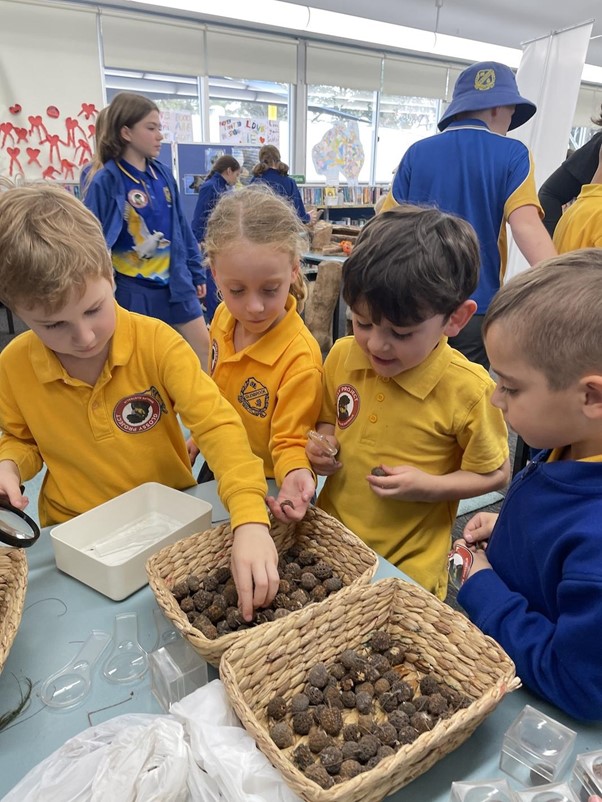
Glenbrook Public School students Ollie, Eadie, Sebe and Max expertly inspect Allocasuarina seed cones. (Photo: courtesy Glenbrook Public School/A. Mostaert)
Ms Samantha Bowden Pongi, the school’s STEM teacher, and a key organiser of this year’s National Science Week event, was particularly keen to focus on these birds because, as an Aboriginal woman, they have a special significance to her.
“The Glossy Black Cockatoo is my totem animal” Samantha revealed, explaining that the cultural significance of this bird is an important aspect of understanding how Indigenous knowledge can help us better understand Australia’s unique native species.

STEM teacher Samantha Bowden Pongi shared Indigenous knowledge of the Glossy Black Cockatoo. (Photo: Gabiann Marin)
More than just sustainability
This year’s National Science Week theme was ‘More than Just Sustainability’ and the organisers at Glenbrook Public School wanted to embrace the whole ethos of the theme, making the week interactive, fun and informative.
“It’s all about changing attitudes about science,” Samantha says as she and four National Science Week Volunteers, Dr Anika Mostaert, Dr Caragh Threlfall, Adrian Faull and Zorana McDavitt planned the event, which included an in-school visit from Feathered Friends Bird Sanctuary as well as tree planting, microscope observations, and assorted informational elements.
Their shared focus for engaging STEM learning was extremely effective. Watching the birds fly across the school hall, as well as learning about the plight of the Glossy Black, inspired the children’s enthusiasm to plant Allocasuarina trees (also known as she-oak) which form the basis of the Glossy Black Cockatoo’s diet.
Many of the children were surprised to learn that just one Glossy Black Cockatoo can get through up to 580 Allocasuarina seed cones per day, with a breeding pair processing over 420,000 pods per year! Cultivating and maintaining this vital food resource is a key way to help support the remaining Blue Mountains Glossy Black population.
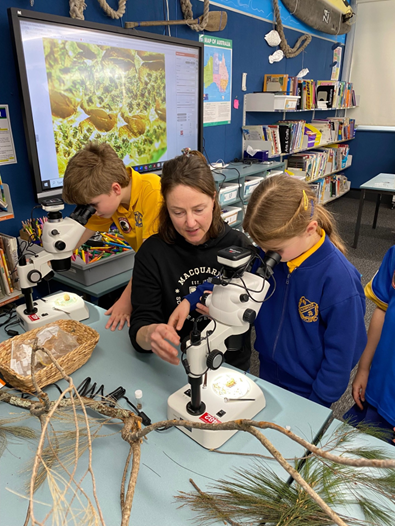
Parent and scientist Dr Caragh Threlfall provided microscopes on loan from Macquarie University. (Photo: Gabiann Marin)
Following up on the free-flight bird experience, the children were treated to their library being transformed into an information hub all about the Glossy Black Cockatoo, with tables hosting different activities and information.
Caragh was on hand to help children engage with the world of the Glossy Black food source, assisting them to use an impressive projection microscope, on loan from Macquarie University for the day, to examine the Allocasuarina pods and tiny seeds.
Zorana was busily explaining the structure of the different cockatoo feather types while Anika explained the habitat hollows provided by local organisation, Hollowhog. STEM teacher Samantha was on hand to help children plant native Allocasuarina seeds and small seedlings while providing key insights into Indigenous knowledge around conservation of the Glossy Black Cockatoo.
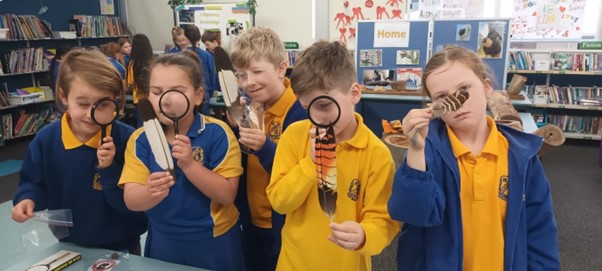
Erik, Odessa, Toby, Harrison and Arlo got a closer look at the Glossy Black Cockatoo during National Science Week. (Photo: Gabiann Marin)
Picking up a magnifying glass as they entered, the children were able to thoroughly examine the array of feathers, inspect Allocasuarina cones and harvest seeds to take a handful home to plant in their own back yards.
After each class walked through the different information stations, they took their Allocasuarina tree seedlings for their class to plant in the school grounds the next day, capping off the week with a dedicated and practical act of conservation and cockatoo kindness.
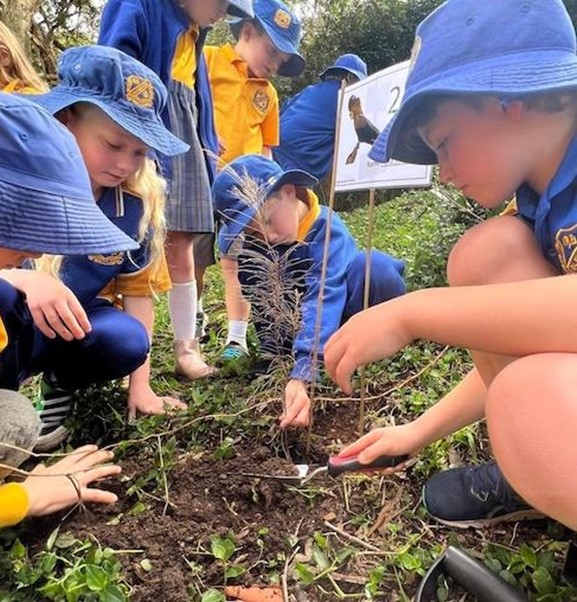
Glenbrook Public School students planted Allocasuarina seedlings as a practical way to help support the Glossy Black Cockatoo. (Photo: courtesy Glenbrook Public School/S. Pongi)
Planting trees is not enough
While planting the trees, which provide both food and nesting for the Glossy Black Cockatoo, is important, it is not enough to save them in the short-term. Glossy Black Cockatoos rely on older, hollowed out trees to make homes for their breeding pairs.
A Glossy Black couple will mate for life and the female only produces one egg every two years, and only if there is a suitable and safe nesting area where she can be sure of her chick’s safety.
With the continuing urbanisation of the mountains over the last 50 years, huge areas of old growth forest have been removed, with hollowed out trees and branches regularly removed from urban and semi urban areas resulting in further loss of habitat for this bird and other species who rely on older trees for their survival.
While safety concerns for humans and human infrastructure is commonly the reason for much of this more recent removal, the fact is that it places pressure on already struggling bird, and greater fauna, populations.
One innovative way to solve this problem was showcased over the day, with local business Hollow Hogs providing a variety of tree hollows with species-specific entry holes which they design and create in living, healthy tree trunks. Trained arborists safely carve out healthy trees to create these hollows as safe nesting options for cockatoos without endangering human activity. The display helped the children to understand how the birds utilise these important spaces.
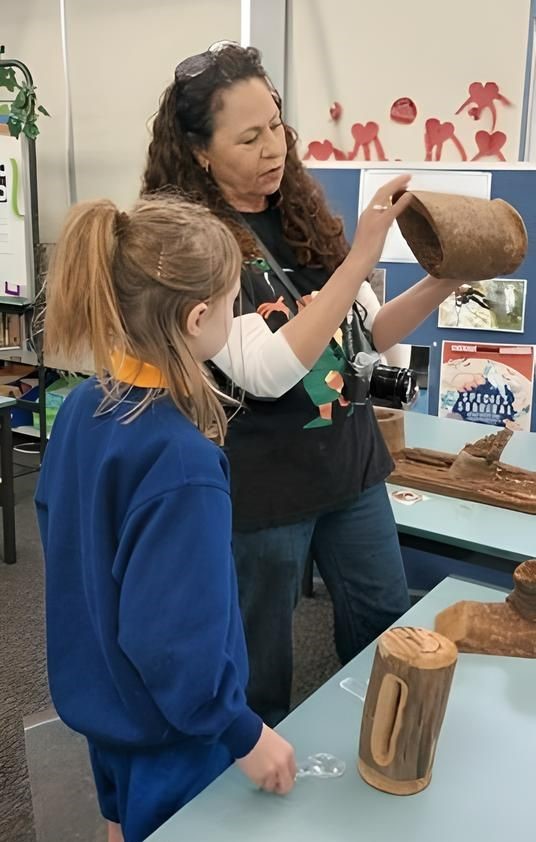
Volunteer Dr Anika Mostaert explained how hollows are a necessary part of Glossy Black Cockatoo Survival. (Photo: Gabiann Marin)
As this year’s National Science Week drew to a close, the children of Glenbrook Public School were able to retain their new-found knowledge and love of Glossy Black Cockatoos, all determined to continue to do their bit to help preserve this beautiful Australian bird, and the ecosystem in which it lives.

Archer & Jack are pleased to lend a helping hand to the Glossy Black Cockatoo. (Photo: Gabiann Marin)
Black Cockatoo Facts
The Glossy Black Cockatoo is one of five main species of black cockatoos found in Australia, all of which are under pressure or active threat due to environmental changes and habitat loss.
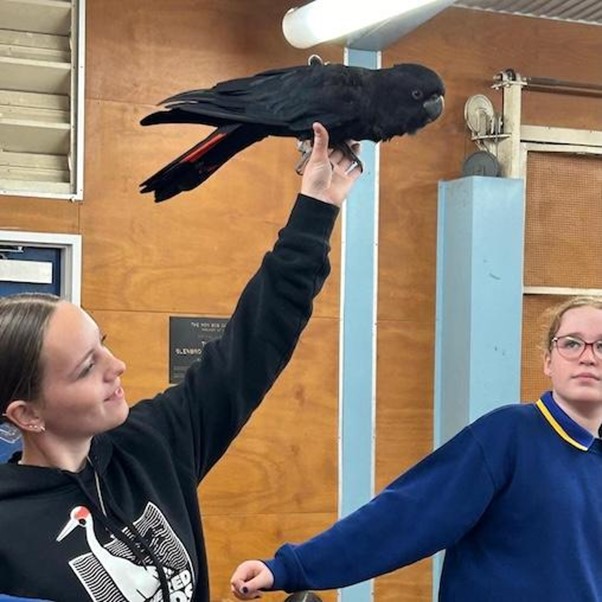
The Glossy Black Cockatoo visited the Glenbrook Public School as part of a demonstration hosted by local wildlife bird Sanctuary Feathered Friends. (Photo: courtesy Glenbrook Public School/A. Mostaert)
Other species include:
The Red-Tailed Black Cockatoo
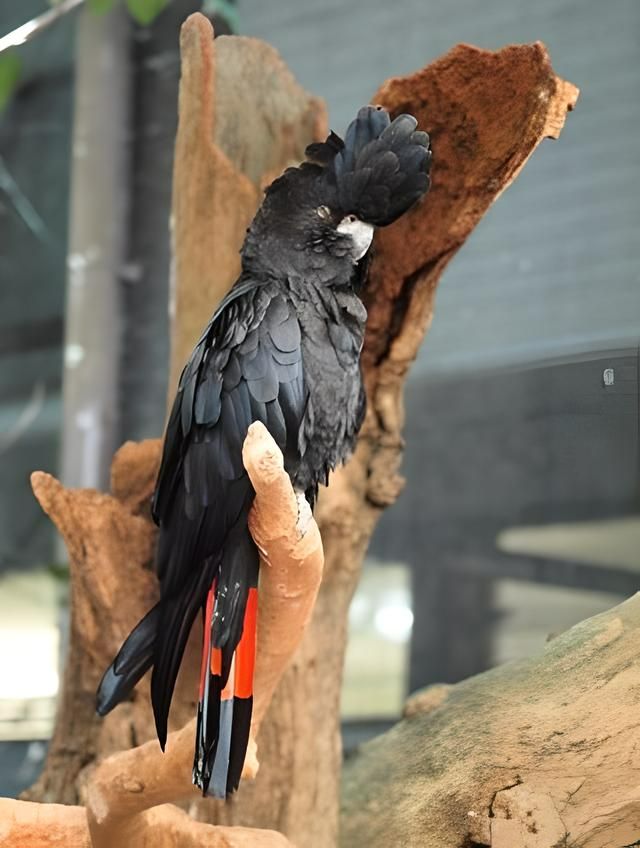
(Photo: Creative Commons – credit Jeremiah Blatz)
Found mostly across Northern NSW these cockatoos have four subspecies but all share a glossy black shine and bright red tail feathers, with the females also exhibiting yellow cheeks. They are currently under threat due to habitat loss
The Yellow Tailed Black Cockatoo
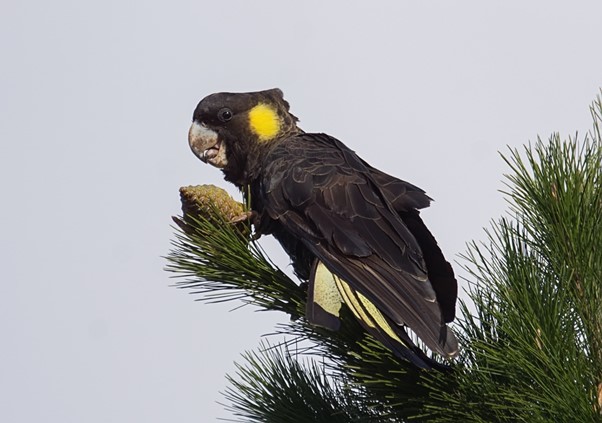
Yellow Tailed Black Cockatoo. (Photo: Creative Commons – credit David Cook)
The most common breed of black cockatoo found in NSW and Victoria. Like the Glossy Black this species makes its home in the Blue Mountains as well as other forested and wooded areas across the two South Eastern states. They have adapted the most effectively to urban development, but are still experiencing a fall in number across their wild populations
Carnaby’s Black Cockatoo
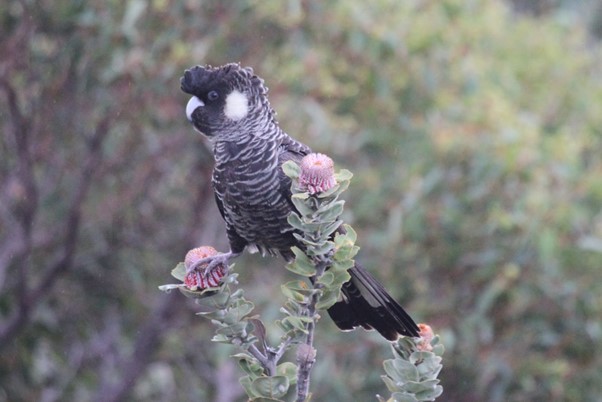
Carnaby’s Black Cockatoo. (Photo: Creative Commons – credit Graham Etherington)
Found only in the south west of Western Australia, this species of black cockatoo is often referred to as the ‘rainbird’ due to its habit of migrating to areas of higher rainfall after its breeding season. This species is the rarest of all cockatoos due to its reliance on increasingly diminishing remnant eucalyptus woodland. Like the Glossy Black Cockatoo, the Carnaby’s Black Cockatoo breeds only once every two years with an average of only one egg per breeding season.
Baudin’s Black Cockatoo
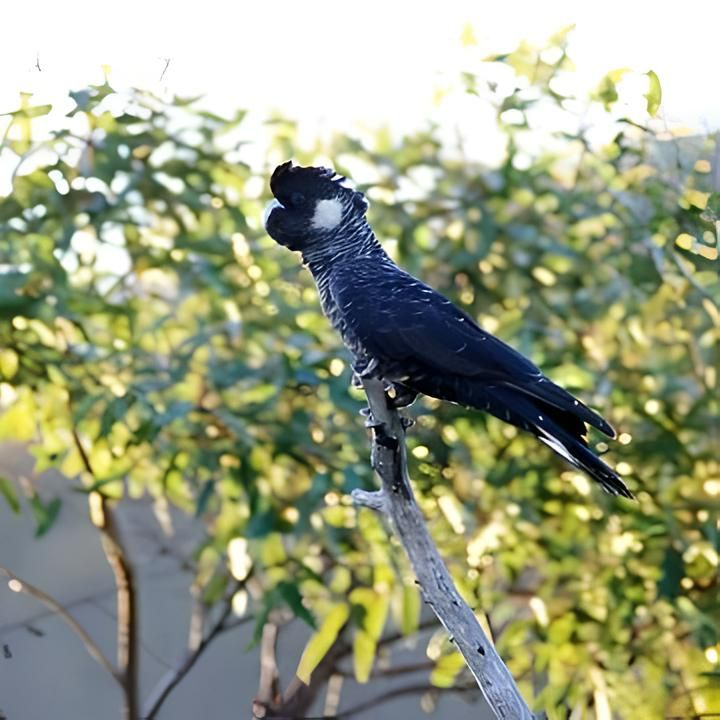
Baudin’s Black Cockatoo. (Photo: Creative Commons – credit Nobuhisa & Seiko Takano)
Similar to the Carnaby’s Black Cockatoo in appearance, and found in a more restricted area of South Western WA, these birds are distinguished by a narrower beak and a more enigmatic nature, which has led to them being less studied and understood than other species of Black Cockatoo. In 2018 their status went from vulnerable to endangered.
Take Action:
- Plant and distribute Casuarina trees and cones. As a main source of food for the Glossy Black Cockatoo, the Allocasuarina is a must have addition to your garden. If you don’t have these plants, think about adding some to your backyard.
- Reduce your urban footprint. Urbanisation is one of the greatest threats to all our native species. While we all need somewhere to live, think about how your home or neighbourhood could be more wildlife friendly. Rewild areas of your garden, allow hollows to remain in trees or consult with an arborist or the hugely knowledgeable team at Hollow Hogs in Hazelbrook (www.hollowhog.com.au) to determine how you could add hollows to trees as safe habitats.
- Help a sanctuary. Bird sanctuaries are key in ensuring the survival of endangered, ill or injured birds. Think about how you could support your local bird sanctuary by volunteering or donating. Feathered Friends is one such organisation. (www.featheredfriends.com.au).
- Learn more about Glossy Black Cockatoos. Knowledge is power so why not learn more about the Glossy Black Cockatoo and the other local, endangered species to determine how you can best help conserve and protect them. BirdLife Australia is a great starting place (www.birdlife.org.au).
- Embrace National Science Week. National Science Week is held annually across Australia and is a great way to engage the entire community with STEM in educational and entertaining ways, to help them build STEM awareness for a bright, positive future. If it doesn’t already, encourage your local school to embrace National Science Week as a way to support STEM curiosity and learning, just like Glenbrook Public School has done.
Share this article:
This story has been produced as part of a Bioregional Collaboration for Planetary Health and is supported by the Disaster Risk Reduction Fund (DRRF). The DRRF is jointly funded by the Australian and New South Wales governments.
